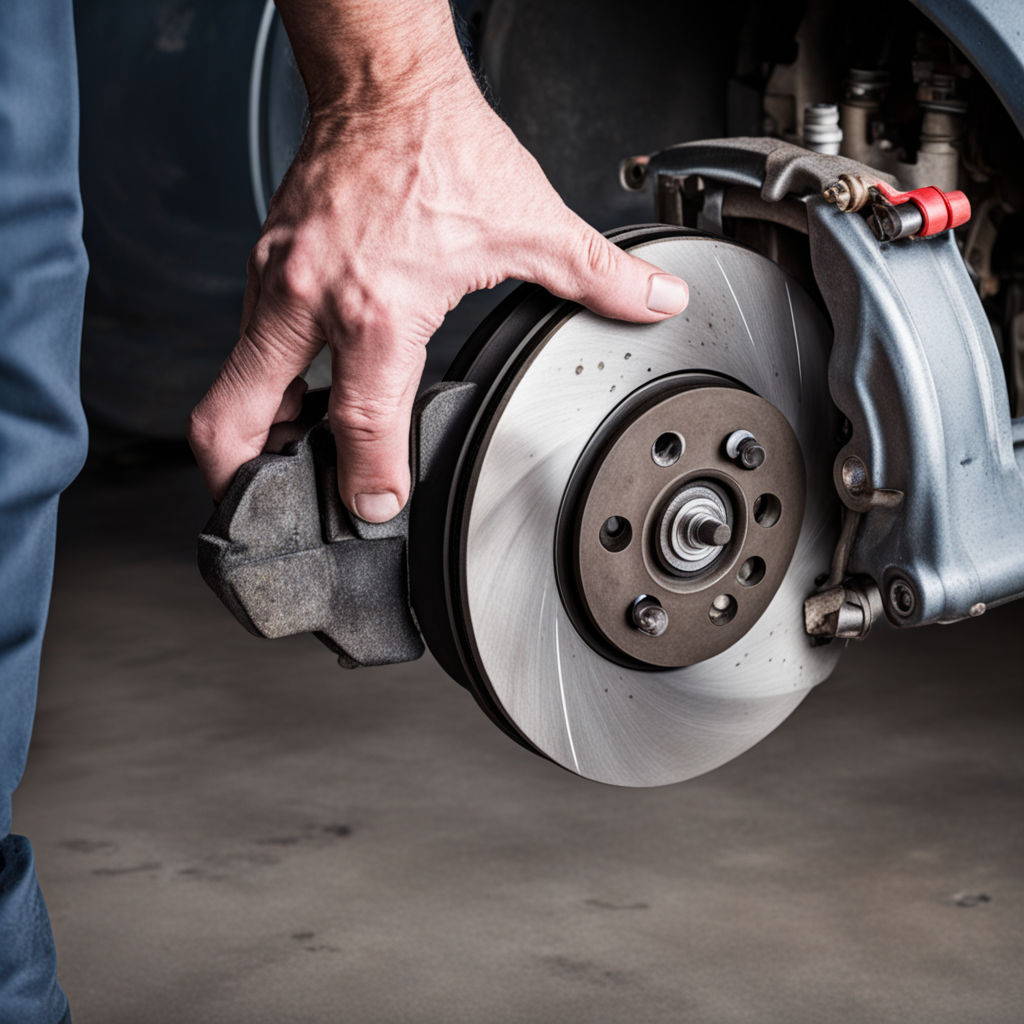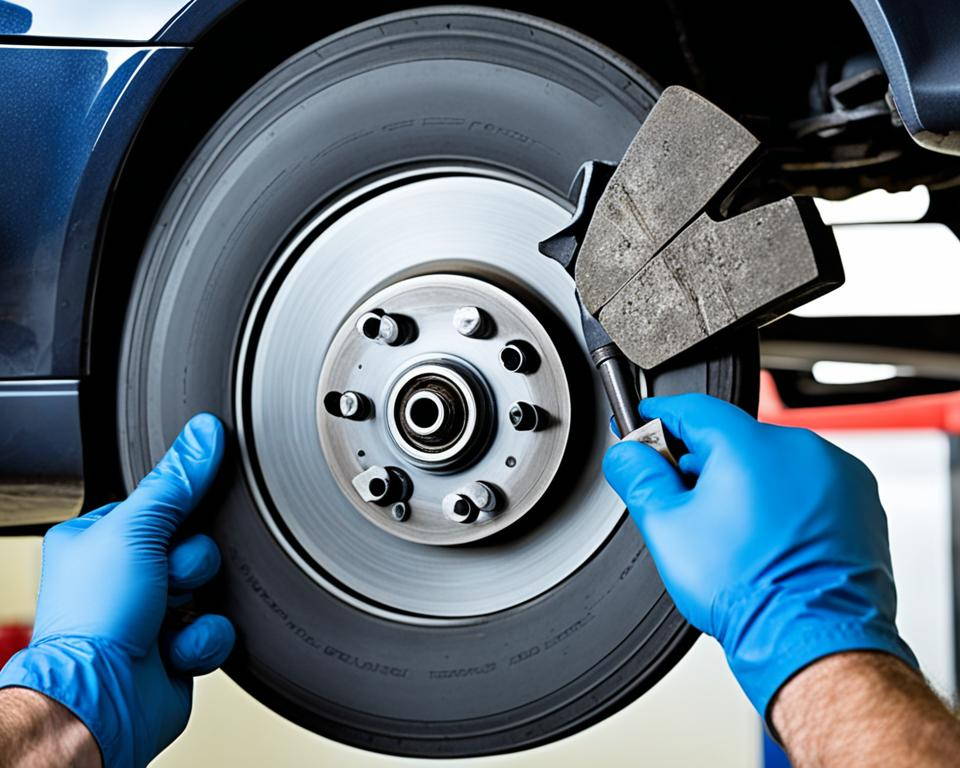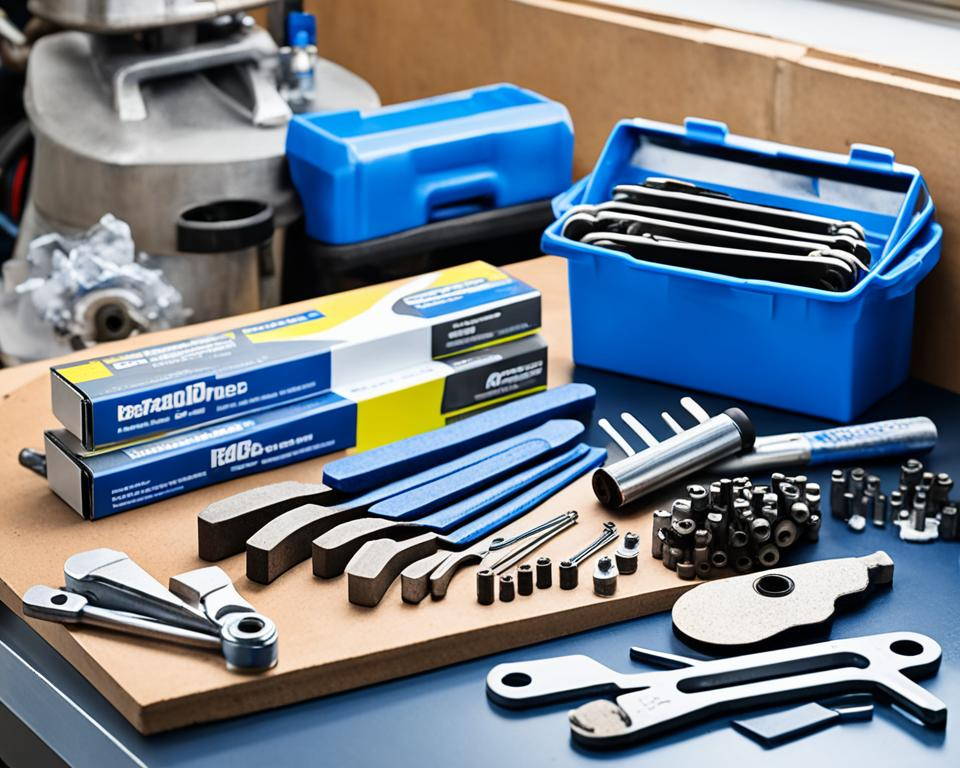
Keeping your car's brakes in good shape is key to your safety and the car's life. Brake pads are a critical part of the brakes and must be replaced often for best performance. This guide will show you how to change your brake pads. We'll cover spotting wear signs and the steps for a successful swap.

Key Takeaways
- Changing your brake pads regularly is vital for your vehicle's safety and performance.
- Old brake pads can make braking less effective, increase stopping distance, and pose a risk to drivers.
- Replacing brake pads on time helps extend your brake system's life and can save you money over time.
- Know the tools and supplies you need for a smooth brake pad replacement at home.
- Follow a detailed guide to safely and effectively swap out your brake pads yourself, avoiding professional service costs.
Importance of Regularly Changing Brake Pads
Keeping your vehicle's brakes in good shape is key to your safety and the car's life. Brake pads are a critical part of this system, making sure your brakes work well. It's important to replace them regularly to keep your car running smoothly and avoid future problems.
Signs of Worn-Out Brake Pads
Knowing when your brake pads need replacing is crucial. Look out for these signs:
- Squeaking or grinding noises when braking
- Reduced braking effectiveness or longer stopping distances
- Visible wear on the brake pads, with the material wearing down to the minimum thickness
- Vibration or pulsing feeling in the brake pedal
Benefits of Timely Brake Pad Replacement
Replacing your brake pads when needed brings many benefits. Your vehicle will stay safe and run well:
- Improved Stopping Power: New brake pads give you the best friction, making your vehicle stop faster and more effectively.
- Reduced Brake Wear: Putting in new pads stops damage to other brake parts, like discs or drums, which can be expensive to fix.
- Enhanced Vehicle Handling: Good brakes mean better control and handling of your vehicle, especially in emergencies.
- Longer Brake Pad Lifespan: Following the maker's advice on when to replace brake pads can make them last longer, saving you money.
Regular brake pad care is a smart move for your safety and peace of mind. By watching for wear signs and replacing pads as needed, you keep your brakes in great shape. This protects you and your loved ones while driving.

Tools and Supplies Needed for Brake Pads Replacement
Changing your vehicle's brake pads is a key maintenance task. It requires the right tools and supplies. Having the right equipment makes the job easier and ensures a good brake pad replacement. Let's look at the essential items you'll need for this DIY project.
Brake Pad Replacement Tools
To replace your brake pads, you'll need these tools:
- A lug wrench to remove the wheel
- A brake caliper tool or C-clamp to compress the caliper piston
- A brake pad gap gauge to measure the space between the pads and rotor
- A torque wrench to properly tighten the lug nuts
- A wire brush or sandpaper to clean the caliper and rotor surfaces
These tools are key for safely removing old pads and installing new ones.
Brake Servicing Supplies
You'll also need these supplies for brake servicing:
- Replacement brake pads that fit your vehicle
- Brake caliper lubricant for smooth movement
- Brake cleaner to remove dirt and residue
- Brake pad anti-squeal lubricant for quiet braking
These supplies help make the brake pad replacement process smoother and more efficient.
Tool or SupplyPurposeLug WrenchRemoves the wheel to access the brake componentsBrake Caliper ToolCompresses the caliper piston to allow for pad removalBrake Pad Gap GaugeMeasures the space between the pads and rotor to ensure proper fitTorque WrenchTightens the lug nuts to the correct specificationWire Brush or SandpaperCleans the caliper and rotor surfaces for a proper installationReplacement Brake PadsNew pads to replace the worn-out onesBrake Caliper LubricantPrevents binding and ensures smooth caliper movementBrake CleanerRemoves dirt, debris, and residue from the brake componentsBrake Pad Anti-Squeal LubricantReduces noise and vibration during braking
Make sure you have all the needed brake pad replacement tools and DIY brake repair tools. This way, you'll be ready for a successful brake pad replacement.

Step-by-Step Guide to Changing Brake Pads
Changing your vehicle's brake pads is key to staying safe on the road. We'll guide you through removing old pads and installing new ones. This way, you can drive with confidence.
Preparing the Vehicle
Park your vehicle on a flat surface and engage the parking brake. Collect your tools: a jack, lug wrench, and new brake pads that fit your car.
Removing the Old Brake Pads
Remove the wheel and find the brake caliper. Loosen the caliper bolts and take off the caliper. Then, pull out the old brake pads and check the brake parts. If the rotors are damaged, think about replacing them for better braking.
Installing the New Brake Pads
Clean the caliper and where the pads sit. Put in the new brake pads. Make sure the caliper is secure and the pads are in place. Do this for each wheel. Test the brakes before driving to make sure they work right.
FAQ
What are the signs of worn-out brake pads?
Worn-out brake pads show up as squeaking or grinding noises when you brake. You might also notice your car doesn't stop as well as it used to. And, the brake pad indicator light on your dashboard might turn on.
How often should I replace my brake pads?
How often you need to replace brake pads depends on how you drive, your car's type, and the pad quality. Generally, experts suggest replacing them every 30,000 to 70,000 miles.
What tools and supplies do I need to change my brake pads?
You'll need a lug wrench, brake caliper tool, brake pad lubricant, a torque wrench, and basic wrenches and sockets to change brake pads.
How do I properly remove and install new brake pads?
Start by preparing your car with the parking brake on and loosening the lug nuts. Next, take out the old brake pads. Clean the caliper and rotor, then apply brake pad lubricant. Finally, put in the new pads as the manufacturer directs.
What are the benefits of timely brake pad replacement?
Replacing your brake pads regularly boosts your car's braking performance. It also reduces wear on other brake parts and makes your car safer and handle better.

